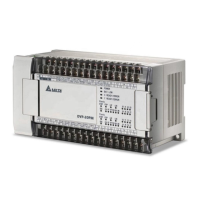5 Applied Instructions and Basic Usage
the mnemonic of API 12 is MOV. If users want to type an instruction by means of PMSoft, they can type
the mnemonic assigned to the instruction. If users want to type an instruction by means of the handheld
programming panel DVPHPP03, they can type the API number assigned to the instruction. Every
applied instruction specifies operands. Take the instruction MOV for instance.
Instruction
code
Operands
X0
MOV
K10 D10
S
D
The instruction is used to move the value in the operand S to the operand D.
S
Source operand
If there is more one source operand, the source operands will be represented by
S
1
, S
2
, and etc.
D
Destination operand
If there is more than one destination operand, the destination operands will be
represented by D
1
, D
2
, and etc.
If operands are constants, they will be represented by m, m
1
, m
2
, n, n
1
, n
2
, and etc.
Length of an operand (16-bit instruction or 32-bit instruction)
The values in operands can be grouped into 16-bit values and 32-bit values. In order to process values
of difference lengths, some applied instructions are grouped into 16-bit instructions and 32-bit
instructions. After “D” is added to the front of a 16-bit instruction, the instruction becomes a 32-bit
instruction.
The instruction MOV is a 16-bit instruction.
X0
MOV K10 D10
When X0 is ON, K10 is moved to D10.
The instruction DMOV is a 32-bit instruction.
X1
D10 D20DMOV
When X1 is ON, the value in (D11, D10) is moved
to (D21, D20).
Continuity instruction/Pulse instruction
The applied instructions can be grouped into continuity instructions and pulse instructions in terms of
the ways the applied instructions are executed. If an instruction in a program is not executed, the
execution of the program will take less time. As a result, if there are pulse instructions in a program, the
scan cycle will be shorter. If “P” is added to the back of an instruction, the instruction becomes a pulse
instruction. Some instructions are mostly used as pulse instructions, e.g. INC and DEC. If appears at
the upper-right side of an instruction, the instruction is generally used as a pulse instruction.
Pulse instruction
X0
D10 D12MOVP
When X0 is turned from OFF to ON, the instruction
MOVP is executed once. MOVP will not be executed
again during the scan cycle, and therefore it is a
pulse instruction.
Continuity instruction
X1
MOV D10 D12
Whenever X1 is ON, the instruction MOV is
executed once. MOV is a continuity instruction.
When the contacts X0 and X1 are OFF, the instructions are not executed, and the values in the
destation operands are not changed.
Operand
1. A word device can consist of bit devices. Applied instructions can use KnX, KnY, KnM, and KnS.
Values can be stored in KnX, KnY, KnM, and KnS.
2. Data registers, timers, counters, and index registers can be used as general operands.
3. A data register is a 16-bit register. If users want to use a 32-bit data register, they have to specify
two consecutive data registers.
4. If a 32-bit instruction uses D0 as an operand, the 32-bit data register composed of D1 and D0 will
be used. D1 occupies the high 16 bits, and D0 occupy the low 16 bits. Timers and the 16-bit
DVP-20PM Application Manual
5-6

